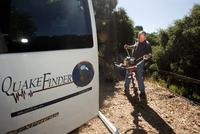-
Redirecting menacing asteroids

Sometime between 2029 and 2036, the asteroid Apophis will come uncomfortably close to Earth; if the asteroid, which weighs forty-six million tons, were to strike Earth, it would cause damage for thousands of miles around the epicenter; scientists propose ways to nudge the menacing asteroid off its current course
-
-
Bacteria--Energy Producers of the Future?
A lot of the water we use daily goes to waste — whether it goes down drains, sewers, or toilets, much of it ends up at a wastewater treatment plant where it undergoes rigorous cleaning before it flows back to the environment; researchers are looking at processes which would turn wastewater into energy
-
-
Sector Report for Monday, 22 August 2011: Infrastructure protection
This report contains the following stories.
Plus 1 additional story.
-
-
Cyber experts dispute McAfee's Shady RAT report

Earlier this month, cybersecurity experts discovered a five-year operation that infiltrated U.S. government and UN computer networks; China is believed to be the culprit behind the systematic attacks, dubbed “Operation Shady RAT,” which also hit major defense contractors and private businesses; many within the cybersecurity community are disputing the significance of the finding
-
-
USSI showcases port security system
To help secure U.S. ports and waterways which provide a vital link to the global supply chain, US Seismic Systems Inc. (USSI) has developed an underwater fiber-optic sonar system that detects small craft entering protected areas
-
-
Tap water in Copenhagen contaminated with E.coli
Parts of the Danish capital Copenhagen were without clean drinking water Saturday after high levels of the E.coli bacteria were detected in the municipal tap water system
-
-
Cleaning water while generating energy
A fuel cell system that can generate electricity from organic compounds and clean up wastewater at the same time has been developed by scientists in China; the cell uses light energy to degrade organic compounds in wastewater, generating electrons that pass through to the cathode, which converts the chemical energy into electrical energy
-
-
Making rail travel more reliable
U.K. researchers are collaborating with industry to develop novel optical sensors that detect when overhead power lines are likely to fail; the costly disruption to rail travel caused by the breakdown of overhead power lines could thus become a thing of the past
-
-
DHS warns copper thefts on the rise

DHS officials warn that copper thefts from critical infrastructure and key resource sectors in the United States are on the rise; in March, a Port of Houston security guard was arrested for giving his friends and families access to the port, where they allegedly stole more than 22,000 pounds of copper
-
-
Researchers develop controversial earthquake detection network

Researchers at a Silicon Valley company are hard at work developing an experimental network of electromagnetic sensors that could predict large earthquakes as much as two weeks in advance; the theory behind the research is disputed, but Tom Bleier, the inventor and chief engineer behind project QuakeFinder, hopes to prove seismologists wrong
-
-
Radiation fears cripple Japanese food exports

Japanese agricultural exports have yet to recover from the 11 March earthquake and tsunami due largely to fears of radioactive contamination; to combat these fears, local governments have done all they can to assure consumers that their products are safe; consumers remain wary despite these reassurances, and as a result the Japanese agricultural sector is struggling
-
-
Autonomous multi-target, multi-user tracking capability
An autonomous multi-sensor motion-tracking and interrogation system reduces the workload for analysts by automatically finding moving objects, then presenting high-resolution images of those objects with no human input
-
-
First quantitative measurements of Fukushima leakage
Atmospheric chemists report the first quantitative measurement of the amount of radiation leaked from the damaged nuclear reactor in Fukushima; the researchers calculated that 400 billion neutrons were released per square meter surface of the cooling pools, between 13 March, when the seawater pumping operation began, and 20 March 2011
-
-
Bill calls for all utility plant worker background checks
Senator Charles Schumer (D-New York) will introduce new legislation that would require all major utility plants to run background checks on its employees; the bill would require FBI background checks on all employees of all major utility plants, strengthening the current requirement which mandates such checks only at nuclear power plants
-
-
New task force helps protect Port of Virginia
A new border security task force has been launched to help secure the Port of Virginia; the task force is comprised of ten officers and agents from a total of ten local, state, and federal agencies that will be responsible for securing the Port of Virginia against a variety of criminal acts including trade fraud, cargo theft, and the illegal smuggling of drugs, persons, currency, and weapons
-
More headlines
The long view
Water Wars: A Historic Agreement Between Mexico and US Is Ramping Up Border Tension
As climate change drives rising temperatures and changes in rainfall, Mexico and the US are in the middle of a conflict over water, putting an additional strain on their relationship. Partly due to constant droughts, Mexico has struggled to maintain its water deliveries for much of the last 25 years, deliveries to which it is obligated by a 1944 water-sharing agreement between the two countries.
Trump Is Fast-Tracking New Coal Mines — Even When They Don’t Make Economic Sense
In Appalachian Tennessee, mines shut down and couldn’t pay their debts. Now a new one is opening under the guise of an “energy emergency.”
Smaller Nuclear Reactors Spark Renewed Interest in a Once-Shunned Energy Source
In the past two years, half the states have taken action to promote nuclear power, from creating nuclear task forces to integrating nuclear into long-term energy plans.
Keeping the Lights on with Nuclear Waste: Radiochemistry Transforms Nuclear Waste into Strategic Materials
How UNLV radiochemistry is pioneering the future of energy in the Southwest by salvaging strategic materials from nuclear dumps –and making it safe.
Model Predicts Long-Term Effects of Nuclear Waste on Underground Disposal Systems
The simulations matched results from an underground lab experiment in Switzerland, suggesting modeling could be used to validate the safety of nuclear disposal sites.
